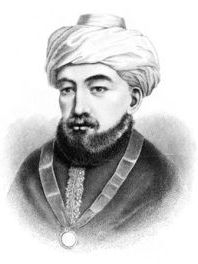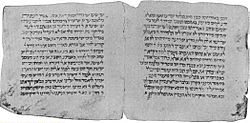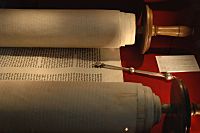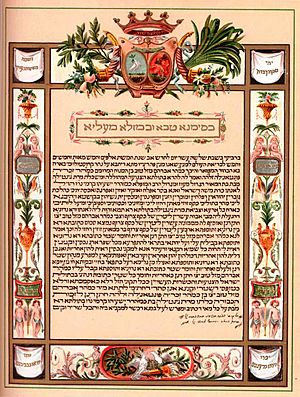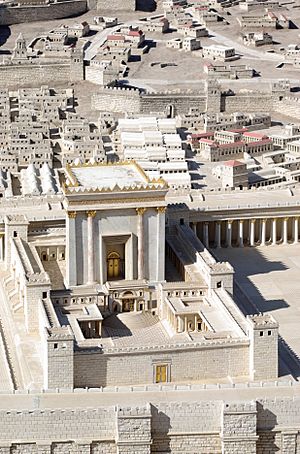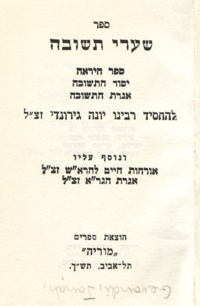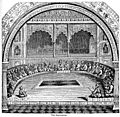Mishneh Torah facts for kids
The Mishneh Torah (which means 'repetition of the Torah' in Hebrew) is a very important book of Jewish religious law. It was written by Maimonides, also known as Rabbi Moshe ben Maimon or Rambam. This huge work was put together between 1170 and 1180 CE while Maimonides lived in Egypt. Many people consider it his greatest work. That's why later on, people often just called the book "Maimon" or "Rambam."
The Mishneh Torah has fourteen books, divided into smaller parts. It's special because it's the only book from the Medieval period that explains all Jewish laws. This includes laws that only apply when the Temple in Jerusalem was standing. It's still a very important book in Judaism today.
The name Mishneh Torah was first used for the Biblical book of Deuteronomy. Its other name, "Book of the Strong Hand" (Sefer Yad ha-Hazaka), comes from its fourteen books. In Hebrew, the number fourteen can be written with the letters Yodh (10) and Dalet (4), which spell yad, meaning 'hand'.
Maimonides wanted to create a full guide to the Oral Law. He hoped that if someone studied the Written Torah and then the Mishneh Torah, they wouldn't need any other books. At first, people had mixed feelings about it. Some were against it because it didn't list its sources. They also worried it might replace the study of the Talmud. Maimonides answered these concerns. Today, the Mishneh Torah is still a very influential book in Jewish thought. Some Jewish leaders even say that Maimonides' decisions should be followed, even if they seem to go against the Talmud. This is because they believed he understood the Talmud perfectly. Later, the Haggahot Maimuniyyot adapted the Mishneh Torah for Ashkenazi communities.
Contents
How Maimonides Wrote the Book
Maimonides wanted his Mishneh Torah to be clear and not too long. He didn't list all his sources in the main text. Instead, he just named them in the introduction. He used the Torah and other parts of the Tanakh. He also used both the Talmuds (Babylonian and Jerusalem), the Tosefta, and other Jewish legal texts.
He also used decisions from earlier Jewish leaders called the Geonim. He would often say, "The Geonim have decided." Sometimes, Maimonides disagreed with what was taught in the name of the Geonim. Some laws in the book don't seem to have a clear source. Scholars think Maimonides either figured them out from the Bible himself. Or, he might have used older versions of Talmudic texts that we don't have anymore. Maimonides himself said he had more accurate Talmud texts than most people back then.
Language and Style of the Book
The Mishneh Torah is written in Hebrew. It uses a style similar to the Mishnah. Maimonides explained that he didn't want to write in Talmudic Aramaic. This was because not many people understood it well. His earlier books had been written in Judeo-Arabic.
The Mishneh Torah almost never explains its sources or arguments. It just states the final Jewish law for each situation. It doesn't discuss how the Talmud is interpreted. The chapters are organized by topic, not by how the laws were figured out. Maimonides was criticized for not including his sources. He later wished he had added them, but he didn't have time to update the book.
What the Mishneh Torah Covers
The Mishneh Torah is divided into fourteen books. Each book covers different areas of Jewish law.
The Fourteen Books
- HaMadda (Knowledge): This book covers basic beliefs in God and good behavior. It also talks about Torah study, avoiding idolatry, and repentance.
- Ahavah (Love of God): This book deals with showing love for God. It includes rules for saying the Shema and praying. It also covers Tefillin, Mezuzah, Sefer Torah, Tzitzit, blessings, and the order of prayers.
-
Zemanim (Times): This book is about special times and holidays. It includes laws for Sabbath, Eruvin (ways to make Sabbath easier), Yom Kippur, and other Jewish holidays. It also covers Passover, Rosh Hashanah, Sukkot, and Hanukkah and Purim.A sukkah booth
- Nashim (Women): This book focuses on laws related to women and family. It includes rules for marriage, divorce, and levirate marriage.
- Kedushah (Holiness): This book is about keeping things holy. It covers forbidden relationships, kashrut (kosher food laws), and Shechitah (ritual slaughter). It also includes laws for converting to Judaism.
- Hafla'ah (Separation): This book deals with different kinds of promises and donations. It covers laws about oaths, vows, Nazirites, and donations to the Temple.
- Zera'im (Seeds): This book is about laws related to farming and land. It includes rules for forbidden mixtures in farming, gifts for the poor, and tithes for priests. It also covers the sabbatical year.
- Avodah (Divine Service): This book describes the rules for serving God in the Temple in Jerusalem. It covers the Temple building, its tools, and the priests' duties. It also details the different types of sacrifices.
- Korbanot (Offerings): This book continues the topic of offerings. It details specific offerings like the Passover offering and offerings for mistakes.
- Taharah (Ritual Purity): This book explains laws about being ritually pure. It covers defilement from death, the red heifer, and rules for mikvah (ritual baths).
- Sefer Nezikim (Torts): This book is about damages and injuries. It covers property damage, theft, robbery, and laws about harming others.
- Sefer Kinyan (Acquisition): This book deals with how things are bought, sold, and owned. It covers sales, gifts, rules for neighbors, and agents.
- Sefer Mishpatim (Civil Laws): This book focuses on everyday civil laws. It includes rules for renting, borrowing, lending, and inheritance.
- Sefer Shoftim (Judges): This book is about judges and the legal system. It covers the Sanhedrin (Jewish court), testimony, and laws for kings and wars.
A Famous Teaching on Charity
The Mishneh Torah includes a well-known list of eight levels of giving to charity (Tzedakah). The first level is the best way to give, and the eighth is the least preferred.
How People Reacted to the Book
Early Critics and Their Concerns
The Mishneh Torah faced strong opposition when it first came out. The main reasons for this were that Maimonides didn't list his sources. Also, some people worried that the book was meant to replace the study of the Talmud. Maimonides himself said that people should spend a third of their study time on the Talmud.
One important critic was Rabbi Abraham ben David of Posquières (Raavad III). His comments are often printed alongside the Mishneh Torah in many editions. Critics were upset because Maimonides used a new way of organizing the laws. They also didn't like that he sometimes based his decisions on the Tosefta or the Jerusalem Talmud, instead of only the Babylonian Talmud.
The biggest criticism was that he didn't list his sources. This made it hard for scholars to check his statements. It seemed like he was forcing them to accept his decisions without question. Despite this, Maimonides was sure that his Mishneh Torah would become very important and accepted in the future.
Yonah of Gerona's Change of Heart
Yonah of Gerona, a cousin of Nachmanides, was one of the early critics of the Mishneh Torah. He was even involved in burning some copies of Maimonides' Sefer ha-Madda in the 1240s. However, he later regretted this. When he saw the Talmud being burned in Paris in 1244, he felt it was a sign from Heaven that he had been wrong. He decided to travel to Land of Israel to ask for forgiveness at Maimonides' grave. He also wrote a famous book about repentance called Shaarei Teshuva ("The Gates of Repentance").
The Book's Lasting Impact
Even with the strong criticism, Maimonides' work quickly became a major authority for Jewish legal decisions. Many Jewish leaders believed that Maimonides' views should be followed. They thought that if he disagreed with earlier teachers, it was because he had a deeper understanding.
Even when later authorities disagreed with Maimonides, Jews from Eastern countries often followed Maimonides. However, European Jews often preferred the opinions of other scholars. Maimonides hoped his book would be the only one needed, but that didn't fully happen. His Mishneh Torah is still very popular, but other Jewish texts are also studied.
It's a bit ironic that Maimonides didn't cite sources to keep the book short. But this often led to the opposite effect. Many commentaries were written just to find the sources he didn't include. Today, the Mishneh Torah is sometimes used as a guide to find passages in the Talmud. When Maimonides' sources are unclear, it can lead to long discussions. This is the opposite of the brevity he wanted.
Different Editions and Accuracy
Over time, many mistakes and changes have appeared in different versions of the Mishneh Torah. These errors can be in the laws themselves, in Maimonides' drawings, or even in how the laws are numbered.
These mistakes happened for several reasons. Some were from copy errors before printing presses existed. Others were from typesetters or people trying to "correct" the text. Also, Maimonides himself often updated his own copy. So, early copies might not have his final changes. Christian censorship in some countries also caused changes.
Sometimes, these errors led to questions about the Mishneh Torah that scholars tried to solve in creative ways. Many of these questions disappear if the text is corrected using reliable old manuscripts.
To find the most accurate version, scholars use early manuscripts. Some of these even have Maimonides' own signature. These manuscripts are free from censorship and changes by later readers. Since the mid-20th century, five main scholarly editions of the book have been printed. These editions try to give the most accurate text based on these old manuscripts.
Commentaries and Later Law Codes
The Mishneh Torah itself has many commentaries written about it. Some famous ones include Magid Mishné and Kesef Mishné. Most of these commentaries try to answer the criticisms of Rabbi Abraham ben David. They also try to find Maimonides' sources in the Talmud, Midrash, and the writings of the Geonim.
Later Jewish law codes, like Arba'ah Turim and Shulchan Aruch, used Maimonides' work a lot. Whole sections are often copied word for word from the Mishneh Torah.
The Mishneh Torah Today
Studying the Book
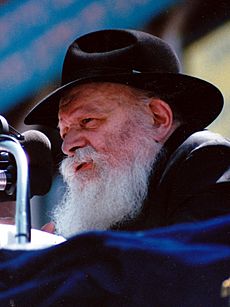
Studying the Mishneh Torah in depth became popular again in Lithuanian Judaism in the late 1800s. These scholars didn't use it for everyday Jewish law, as they followed other authorities. Instead, they used it to understand how the Talmud was interpreted. They would compare the Talmudic texts with Maimonides' final decisions. This helped them figure out the rules of interpretation Maimonides must have used.
Because of this, the Mishneh Torah is still a key part of the Yeshiva (Jewish school) curriculum. It's one of the main books used to understand the Talmud from a legal point of view. It's also a primary text for understanding Jewish law as presented in other codes. So, it's one of the first books scholars check when they have a question about Jewish law.
Many important rabbis have written commentaries on the Mishneh Torah. These include Rabbi Menachem Mendel Schneerson, known as the Lubavitcher Rebbe. He encouraged Jews to study the Mishneh Torah every day. Thousands of Orthodox Jews, especially Chabad Hasidim, now follow an annual study cycle of the Mishneh Torah.
Putting the Laws into Practice
For everyday Jewish law, most Jews follow other Rabbinic codes. However, a growing number of Yemenite Jews and others are choosing to follow the Mishneh Torah as their main guide. They see it as returning to the original customs of their ancestors.
Rabbi Yiḥyah Qafiḥ helped start this trend in Yemen. The Mishneh Torah had always been a leading authority for the traditional Yemenite community. His grandson, Rabbi Yosef Qafiḥ, continued this work. Yosef Qafiḥ published a huge commentary on the Mishneh Torah. His edition is based on the accurate handwritten manuscripts kept by the Yemenite Jewish community. His introduction to the book is famous for defending the practice of following the Mishneh Torah.
Today, Rabbi Rasson Arusi is a leading public figure for the traditional Yemenite and "Rambamist" communities. He has published several books with commentaries on the Mishneh Torah.
Historical Connections
Scholars who study the history of Judaism in ancient China have noticed interesting similarities between the Mishneh Torah and the practices of the Kaifeng Jews. These Jews were descendants of Persian merchants who settled in China.
The Mishneh Torah was also used by the Jews of India during Maimonides' time. Maimonides himself mentioned that copies of his code were sent to communities as far as India, which helped revive religious life there. A letter from 1535 also supports this. It said that Jews in the Indian town of Shingly (Cranganore) "only recognize the Code of Maimonides and possessed no other authority or Traditional law."
Translations of the Mishneh Torah
The first known English translation of the Mishneh Torah was made in 1832 by Herman Hedwig Bernard. He was a professor of Hebrew at Cambridge University.
The Yale Judaica Series began publishing an English translation of the Mishneh Torah in 1949. This series is almost complete. Moznaim Publishing Corporation has also published an English translation by Rabbi Eliyahu Touger, which is available online.
Images for kids
-
A sukkah booth
-
Herod's Temple, as imagined in the Holyland Model of Jerusalem
-
Title page of Karo's Shulchan Aruch
-
Rabbi Menachem Mendel Schneerson, known as the Lubavitcher Rebbe, studied the Mishneh Torah daily and encouraged other Jews to follow along with him in an annual study cycle.
See also
 In Spanish: Mishné Torá para niños
In Spanish: Mishné Torá para niños
- List of commentaries on Mishneh Torah
- Hebrew translations of all of Maimonides' Jewish works (as opposed to, e. g., medical) by Rabbi Yosef Kapach: Rambam
- Shulchan Aruch


